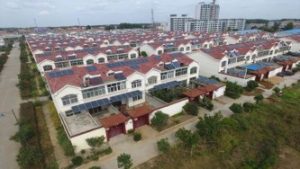TrinaHome, from Trina Solar seeks to get rooftop segment going with aggressive pricing
 Trina in your Homes
Trina in your Homes
Trina Solar is moving into the household and small-to-medium enterprise (SME) sector with the launch of Trinahome, its residential solar solutions.
The news was formally announced on the eve of next week’s Renewable Energy India Expo being held in Noida on 18-20 September. Trina Solar is a key exhibitor at this year’s show. Closely following Tata Power Solar’s launch of the residential solutions, the Chinese PV maker says this is India’s first Home kit.

According to the company, TrinaHome is ‘all-in-one’ solar residential solution. The kit includes all the required solar rooftop components – modules, inverter, grid box and mounting system – and is backed by Trina Solar warranties, including a 25-year module performance warranty.
It is available in variations of 3 kW, 5 kW and 10 kW, with different mounting systems for different roof-types, and also has a dedicated app through which customers can monitor power generation. While the company did not share any pricing details, a call to an authorised dealer got us a price of RS 47,000+GST per KW for outright Kit purchase, while a situation where you opt for a turnkey solution including net metering permissions would go upto Rs 54,000 plus GST. Those rates, if valid, compare very well with existing rates in the market from Tata Power Solar in particular.
“Trina Solar is already number one in India’s solar energy market thanks to the large-scale utility projects, namely solar farms, we have already completed. We have provided solar cells and modules to many developers in India,” says Yin Rong Fang, Trina Solar president of global sales and president of overseas commercial and residential solutions.
Trina has, to date, been active in India’s large-scale utility and commercial solar sectors, so the launch of TrinaHome marks its entry into the household and small and medium enterprises (SME) sector. Here, the company aims to capture 5-8% of the country’s total residential solar market.
Yin is optimistic about his company and says, “Trina Solar supplied 3.5GW, so we accounted for 15% of the total. That means we are the clear market leader here in India.”
India is also Trina Solar’s second largest market in Asia Pacific after China. “Trina Solar was founded in China in 1997 and has been in India since 2010,” added Yin.
Trina Solar India director, Gaurav Mathur, says, “We recognize that B2B (business-to-business) is very different to B2C (business-to-consumer). Prior to today’s launch, we have been working behind the scenes to develop a nationwide customer service network, so we can reach consumers in all the towns and cities in India. This includes even those in the most remote rural areas.” Trina Solar has been signing up with local partners throughout the country, namely distributors and installers.
Mathur says, “The reason we decided to move into the household sector, is because we can see there is enormous market opportunity to bring solar energy to Indian consumers.”
The Indian government has set a goal of 100GW of solar energy capacity by 2022 of which 60GW is to come from solar energy utility projects and 40GW from rooftop solar energy. and with installed capacity barely crossing 25GW, there is much scope for companies like Tata Power solar, Amplus, Zunroof and Trina Solar, especially in the rooftop segment, where the numbers have been lagging.
“India has made good progress in working towards achieving the government’s target of 60GW of solar energy utility capacity by 2022. But the country is lagging behind when it comes to achieving the 40GW target for rooftop,” he says.
According to media reports, cumulative solar installed capacity totalled 24.6 GW at the end of second quarter in 2018 with large-scale solar projects accounting for 90 percent and rooftop solar making up the remaining 10 percent.
Mathur says, “Trinahome will help to boost demand in the market for rooftop by giving SMEs and households an easy and affordable solution.”
Mathur says, “This makes it very easy for the consumer, because they know that the whole system is backed by one manufacturer. It also means the components work together seamlessly to provide greater energy efficiency.”
“The key benefit of solar energy is you will be more self-sufficient and can reduce your energy bills. Solar energy is also a renewable resource, so it is better for the environment than relying on electricity generated from fossil fuels, such as coal,” he adds.
He also said, “One of the key factors driving people to adopt solar energy is because the cost of electricity, from fossil fuels, keeps increasing,”and added “Electricity prices can have a big impact on total household and business expenses.”
While the kit is currently imported from China, Trina says it is in the process of identifying and approving local component suppliers, with the goal of assembling it in India in the next four to six months.
The final price has not, yet, been announced.
Launched in August 2017, TrinaHome is currently available in China, Asia Pacific/Middle East/Africa (APMEA geographical region). The company aims to provide its residential PV systems to one million households in five years. So far, it has touched the 180,000 mark. And with its launch here, while consumers here will have more options, domestic solutions providers will have to tighten their belts for more competition.




